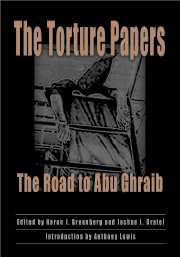Timeline
Published online by Cambridge University Press: 05 June 2012
Summary
September 14, 2001: President Bush issues “Declaration of National Emergency by Reason of Certain Terrorist Attacks.”
September 25, 2001: John Yoo, Deputy Assistant Attorney General, U.S. Department of Justice advises Timothy E. Flanigan, Deputy Council to the President, that the President has “broad constitutional power” in the matter of military force, military pre-emption and retaliatory measures against terrorists (persons, organization or States) and those who harbor them.
October 7, 2001: President Bush announces that on his orders, “the United States military has begun strikes against al Qaeda terrorist training camps and military installations of the Taliban regime in Afghanistan.”
November 13, 2001: George W. Bush, “Military Order of November 13, 2001,” “Detention, Treatment and Trial of Certain Non-Citizens in the War Against Terrorism,” authorizes the detention of alleged terrorists and subsequent trial by military commissions that, given the threat of terrorism, should not be subject to the same principles of law and rules of evidence recognized in US criminal courts.
December 28, 2001: Deputy Assistant Attorney General John C. Yoo and Deputy Assistant Attorney General Patrick F. Philbin advise William J. Haynes II, General Counsel, U.S. Department of Defense, that Federal Courts in the United States lack jurisdiction to hear habeus corpus petitions of prisoners held in Guantánamo Bay, Cuba. This opinion becomes the basis of the government's legal strategy of trying to prevent detainees from challenging their detention in U.S. courts.
- Type
- Chapter
- Information
- The Torture PapersThe Road to Abu Ghraib, pp. xxv - xxviiiPublisher: Cambridge University PressPrint publication year: 2005



